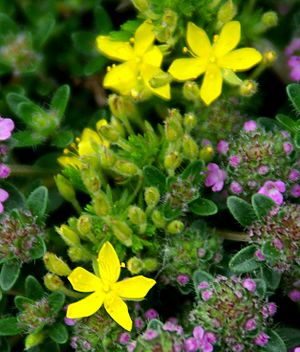Pine barren goldenheather facts for kids
Quick facts for kids Pine barren goldenheather |
|
|---|---|
 |
|
| Conservation status | |
| Scientific classification | |
| Genus: |
Hudsonia
|
| Species: |
ericoides
|
Hudsonia ericoides is a cool little plant often called pine barren goldenheather. It's also known as false heather or golden-heather. This plant is part of the rock-rose family. You can find it growing along the east coast of North America. It stretches from Newfoundland all the way down to Delaware. There's even a special group of them, called a disjunct population, far away in South Carolina.
What is Pine Barren Goldenheather?
This plant is a shrub, which means it's a small, woody plant. It grows very low to the ground. It often forms a thick, bushy mat that can spread up to a meter (about 3 feet) wide.
The plant has a main root called a taproot. This root grows deep into the soil. It also has many thin, fibrous roots that stay close to the surface. These roots help it get water and nutrients.
Its branches are covered with tiny, green leaves. They look like little needles. Each leaf is only a few millimeters long. They are very thin, less than half a millimeter wide.
Where Does it Grow?
Pine barren goldenheather mostly lives in plant communities found near the coast. These are places like pine barrens. Pine barrens are forests with lots of pine trees.
You can find it a lot in the Pine Barrens of New Jersey. It's also common on Cape Cod, Martha's Vineyard, and Nantucket in Massachusetts. On Long Island, it grows alongside pitch pines.
This plant loves dry, sandy soils. It grows easily on dunes and beaches. These places often have humid and windy weather.
How Does it Survive?
Pine barren goldenheather needs lots of sunshine. It does not grow well in shady spots. You'll find it thriving in open, sunny areas.
This shrub is a pioneer species. This means it's one of the first plants to grow in new or disturbed areas. You might see it growing along roadsides.
It's also common in places that have frequent wildfires. Pine barrens often experience these fires. The plant is adapted to survive and even thrive after fires.
Some types of this plant are at risk of disappearing. One type is even thought to be extinct.


